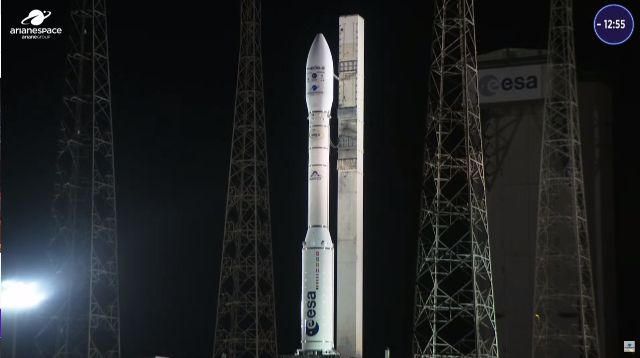Editor’s note: Arianespace scrubbed the planned Oct. 6 launch of its Vega rocket late in the countdown clock. The company is currently conducting checks to determine if it will go for a launch attempt at 9:36 p.m. EDT on Oct. 7.
A Vega rocket may launch 12 satellites to orbit tonight (Oct. 7) on its first mission of the year, and you can watch the action live.
The Vega, which is operated by France-based company Arianespace, is scheduled to lift off from Europe’s Spaceport in Kourou, French Guiana tonight, Oct 7, at 9:36 p.m. EDT (0136 GMT on Oct. 8). An attempt to launch the mission on Oct. 6 was called off when a “red status” interrupted the countdown in the final minute due to a measurement on the Vega rocket that was “slightly above its maximum threshold,” Arianespace officials said in a statement.
“Additional checking is being conducted to confirm a new launch attempt on Saturday, October 7 at 10.36 p.m. (local time in Kourou – 01.36 a.m. on October 8 UTC),” officials wrote. You can watch the launch tonight live here at Space.com, courtesy of Arianespace, or directly via the company, if the Vega launch goes ahead.
Related: Vega rocket launches Earth observation satellite and 4 cubesats into orbit
The 100-foot-tall (30 meters) Vega is designed to loft relatively small payloads. It’s capable of carrying 3,300 pounds (1,500 kilograms) to a circular orbit 435 miles (700 kilometers) above Earth, according to Arianespace’s spec sheet.
The Vega debuted in February 2012 and has flown 22 times to date, which explains the name Arianespace has given to tonight’s mission: VV23. The flight will be the first for the standard Vega variant since November 2021.
Its upgraded, more powerful cousin, the Vega-C, has flown twice since then, in July 2022 and December 2022. The latter of those two Vega-C missions — its second ever — ended in failure, due to a flaw in the nozzle used on the rocket’s second stage.
There are two main payloads going up on VV23: THEOS-2 (“Thailand Earth Observation System-2”), a 919-pound (417 kg) Earth-imaging satellite that will be used by the government of Thailand; and FormoSat-7R/Triton, which was developed by Taiwan’s space agency.
The 531-pound (241 kg) FormoSat-7R/Triton “is equipped with the Global Navigation Satellite System-Reflectometry (GNSS-R), which collects signals that bounce off the sea surface,” Arianespace wrote in a press release. “It helps scientists calculate the wind field over the oceans. This data will be shared with the global meteorology community, contributing to the forecast of typhoon intensity and trajectory.”
VV23 will also loft 10 other payloads for six different customers, which you can read more about in the press release. Altogether, the 12 satellites launching tonight weigh 2,738 pounds (1,242 kg), according to Arianespace.

